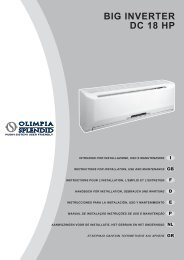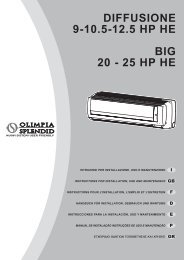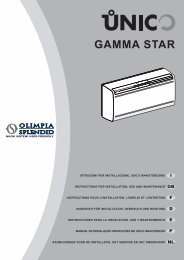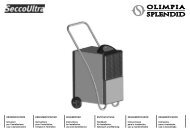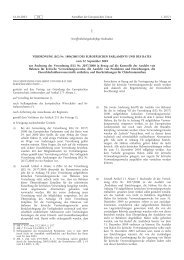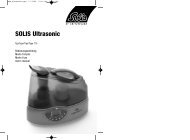MANUALE MULTIFLEXI INVERTER.pmd - KlimaShop!
MANUALE MULTIFLEXI INVERTER.pmd - KlimaShop!
MANUALE MULTIFLEXI INVERTER.pmd - KlimaShop!
Create successful ePaper yourself
Turn your PDF publications into a flip-book with our unique Google optimized e-Paper software.
44<br />
2<br />
I<br />
Nel caso non si utilizzino tubazioni<br />
preisolate, inserire i tubi nell’isolante<br />
che deve avere le seguenti caratteristiche:<br />
- materiale: poliuretano espanso<br />
a celle chiuse<br />
- coefficiente di trasmissione max:<br />
0,45 W/ (Kxm 2 ) ovvero 0.39 kcal/<br />
(hxCxm 2 )<br />
- spessore minimo: 6 mm (per le<br />
linee del liquido)<br />
- spessore minimo: 9 mm (per le<br />
linee del gas)<br />
Non inserire entrambe le tubazioni<br />
nella medesima guaina,<br />
si compromette il perfetto<br />
funzionamento dell’impianto<br />
(fig. 26 B).<br />
- Unire accuratamente con nastro<br />
adesivo le eventuali giunzioni<br />
della guaina.<br />
- Infilare nel tubo, prima di eseguire<br />
la cartellatura, il dado di<br />
fissaggio (fig. 27 A).<br />
- Eseguire la cartellatura sulle estremità<br />
dei tubi, utilizzando l’apposito<br />
utensile, in modo impeccabile,<br />
senza rotture, incrinature o<br />
sfaldature (fig. 27 B).<br />
- Lubrificare il filetto dell’attacco con<br />
olio per refrigerante (NON UTILIZ-<br />
ZARE NESSUN ALTRO TIPO DI<br />
LUBRIFICANTE)<br />
- Avvitare manualmente il dado del<br />
tubo sulla filettatura dell’attacco<br />
- Avvitare definitivamente<br />
utilizzando una chiave<br />
fissa per tenere ferma la<br />
parte filettata dell’attacco,<br />
per evitarne deformazioni,<br />
e una chiave<br />
dinamometrica, sul dado<br />
(fig. 28) tarata con i<br />
seguenti valori in base<br />
alle dimensioni dei tubi:<br />
- 14-18 Nxm (1,4-1,8 kgxm) per<br />
diametro tubi ø 6-6,4 mm<br />
- 33-40 Nxm (3,3-4,0 kgxm) per<br />
diametro tubi ø 9,5-10 mm<br />
- 50-60 Nxm (5,0-6,0 kg-m) per<br />
diametro tubi ø 12-12,7 mm.<br />
25<br />
GB F D<br />
If you do not use preinsulated pipes,<br />
they must be insulated as follows:<br />
- material: polyurethane foam with<br />
closed cells<br />
- max. coefficient of transmission:<br />
0,45 W/ (Kxm 2 ) or 0.39 kcal/<br />
(hxCxm 2 )<br />
- minimum thickness: 6 mm (for<br />
liquid pipes)<br />
- minimum thickness: 9 mm (for gas<br />
pipes)<br />
Do not place both pipes in the<br />
same sheath, as this would<br />
jeopardize the proper operation<br />
of the system (fig. 26 B).<br />
- Bind any joints in the sheath<br />
securely with insulating tape.<br />
- Before flaring the pipe ends, insert<br />
the fastening nut (fig. 27 A).<br />
- Flare the pipe ends using the special<br />
tool. Take care not to break, crack<br />
or split the pipe (fig. 27 B).<br />
- Lubricate the connecting thread with<br />
oil for coolant (DO NOT USE<br />
ANY OTHER TYPE OF<br />
LUBRICANT)<br />
- Screw the pipe nut manually on the<br />
connecting thread<br />
- Tighten using a wrench to<br />
hold the threaded part of<br />
the connector, so as to<br />
avoid twisting the pipe,<br />
and a dynamometric<br />
wrench on the nut (fig. 28)<br />
calibrated with the<br />
following values<br />
depending on the size of<br />
the pipe:<br />
- 14-18 Nxm (1.4-1.8 kgxm) for pipe<br />
diameter ø 6-6.4 mm<br />
- 33-40 Nxm (3.3-4.0 kgxm) for pipe<br />
diameter ø 9.5-10 mm<br />
- 50-60 Nxm (5.0-6.0 kg-m) for pipe<br />
diameter ø 12-12.7 mm.<br />
Si l’on n’utilise pas de tuyauterie préisolée,<br />
introduire les tuyaux dans l’isolant qui doit<br />
avoir les caractéristiques suivantes:<br />
- matériau: polyuréthanne expansé<br />
à cellule fermées<br />
- coefficient de transmission<br />
maxi:0,45 W/ (Kxm 2 ) soit 0.39<br />
kcal/(hxCxm 2 )<br />
- épaisseur minimum: 6mm (pour<br />
les conduit es du liquide)<br />
- épaisseur minimum: 9 mm (pour<br />
les conduites du gaz)<br />
Ne pas introduire les deux<br />
tuyaux dans la même<br />
gaine, cela compromet le<br />
fonctionnement parfait de<br />
l’installation (fig. 26 B).<br />
- Raccorder soigneusement avec du<br />
ruban adhésif les éventuelles<br />
jonctions de la gaine.<br />
- Enfiler l’écrou de blocage sur le<br />
tuyau, avant d’évaser l’extrémité<br />
(fig. 27 A).<br />
- Evaser les extrémités des tuyaux,<br />
en utilisant l’outil prévu à cet effet,<br />
de manière impeccable, sans<br />
cassures, fentes ou clivages (fig.<br />
27 B).<br />
- Lubrifier le filet du raccord avec de<br />
l’huile pour frigorigène<br />
(N’UTILISER AUCUN AUTRE<br />
TYPE DE LUBRIFIANT)<br />
- Visser manuellement l’écrou du<br />
tuyau sur le filetage du raccord<br />
- Serrer à fond en utilisant<br />
une clé à fourches pour<br />
maintenir bloquée la<br />
partie filetée du raccord,<br />
afin d’éviter des déformations,<br />
et une clé dynamométrique<br />
sur l’écrou (fig.<br />
28) réglée aux valeurs<br />
suivantes selon les<br />
dimensions des tuyaux:<br />
- 14-18 Nxm (1,4-1,8 kgxm) pour un<br />
diamètre des tuyaux ø 6-6,4 mm<br />
- 33-40 Nxm (3,3-4,0 kgxm) pour un<br />
diamètre des tuyaux ø 9,5-10 mm<br />
- 50-60 Nxm (5,0-6,0 kg-m) pour un<br />
diamètre des tuyaux ø 12-12,7<br />
mm.<br />
26<br />
B<br />
Kommen keine vorisolierten Rohrleitungen<br />
zur Anwendung, sind diese mit einem<br />
Isolierstoff zu ummanteln, der die folgenden<br />
Merkmale aufweisen muss:<br />
- Material: PUR-Schaum mit<br />
geschlossenen Zellen<br />
- Max. Wärmedurchgangszahl:<br />
0,45 W/(Kxm2) oder 0.39 kcal/<br />
(hxCxm 2 )<br />
- Mindeststärke: 6 mm<br />
(flüssigkeitsführende Rohrleitungen)<br />
- Mindeststärke: 9 mm<br />
(Gasleitungen)<br />
Auf keinen Fall dürfen beide<br />
Rohrleitungen in<br />
dieselbe Ummantelung<br />
eingeführt werden, da die einwandfreie<br />
Funktionsweise<br />
der Anlage beeinträchtigt<br />
werden könnte (Abb. 26 B).<br />
- Eventuelle Verbindungsstellen der<br />
Ummantelung sind sorgfältig mit<br />
Klebeband zu umkleben.<br />
- Vor dem Begrenzungsanschlag ist<br />
die Befestigungsmutter auf das Rohr<br />
zu schieben (Abb. 27 A).<br />
- Der Begrenzungsanschlag an den<br />
Enden der Rohre ist mit Sorgfalt<br />
durchzuführen. Die Rohre dürfen<br />
hierbei in keiner Weise beschädigt<br />
werden (Abb. 27 B).<br />
- Das Gewinde des Anschlussstücks<br />
mit Kühlöl schmieren. ES DARF<br />
KEIN ANDERES SCHMIER<br />
MITTEL VERWENDET<br />
WERDEN.<br />
- Die Mutter des Rohrs von Hand auf<br />
das Gewinde des Anschlussstücks<br />
anschrauben.<br />
- Danach die Mutter fest<br />
anziehen. Zu verwenden<br />
sind hierfür ein<br />
Maulschlüssel, durch den<br />
das Gewinde des<br />
Anschlussstücks zur<br />
Vermeidung von Deformationen<br />
zu blockieren ist,<br />
und ein an der Mutter<br />
anzulegender dynamometrischer<br />
Schlüssel (Abb.<br />
28), der zuvor je nach<br />
Rohrdurchmesser auf<br />
folgende Werte geeicht<br />
wurde:<br />
- 14-18 Nxm (1,4-1,8 kgxm) für<br />
Rohrdurchmesser ø 6-6,4 mm<br />
- 33-40 Nxm (3,3-4,0 kgxm) für<br />
Rohrdurchmesser ø 9,5-10 mm<br />
- 50-60 Nxm (5,0-6,0 kg-m) für<br />
Rohrdurchmesser ø 12-12,7 mm.<br />
A



